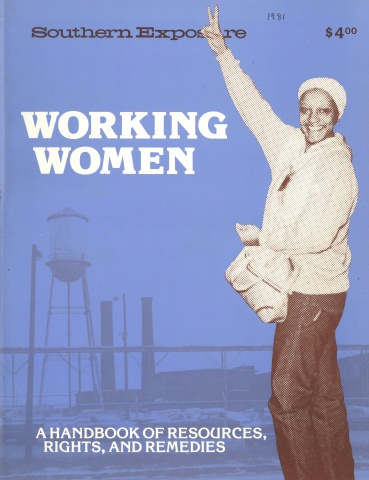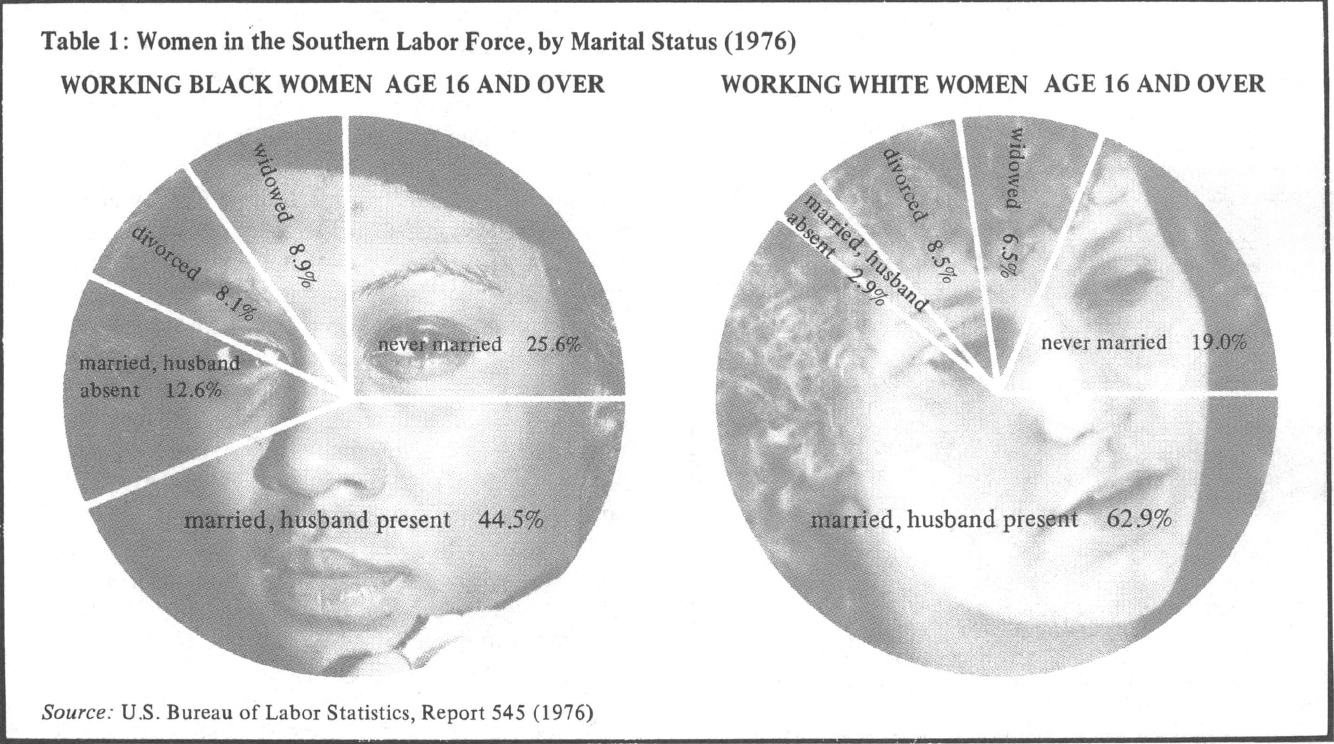
This article originally appeared in Southern Exposure Vol. 9 No. 4, "Working Women: A Handbook of Resources, Rights, and Remedies." Find more from that issue here.
Anyone who reads about female bank presidents and airline pilots probably thinks that women are making significant gains in the work force. They might also believe that women, in general, are making good money, holding prestigious jobs and even putting men out of work. The reality for most Southern working women has been, and continues to be, one of long hours and low wages. Many Southern working women bear the double burden of providing for their families and providing a cheap source of labor for Southern industry.
The notion that women’s earnings have “caught up to” or surpassed men’s earnings is a myth. Women are still far behind men in earnings, authority and prestige in the working world. Statistics on women in the work force show more women working than ever before, but they are, for the most part, poorly paid, lacking in advancement opportunities, and still stuck in the same low-paying, low-status jobs in which they have always worked. Black women have it worse than white women because they have to face both racism and sexism in the workplace. In addition, most working women finish their paid work only to do unpaid work in the home.
The myths about working women in the South and across the nation underlie the relationship between women’s low status in the workplace and their status in society as a whole. To this end, Southern Exposure examines four commonly held myths about working women. The figures show that working women put far more into the Southern economy and into family life than they get in return.*
Myth 1: Most adult-age women do not work outside the home. Only a few married women
are employed in the work force.
Fact: In 1978, 48 percent of Southern white women and 52 percent of Southern black women were in the labor force. Almost half of all Southern women living with their spouses were employed.
Southern women are entering the labor force in greater numbers than ever before. Women made up a hefty 42 percent of the entire Southern labor force in 1978. Over the past decade, women have accounted for 54 percent of the total increase in workers nationwide, a proportion likely to increase during coming years. This trend is illustrated in Table 2.
Black women are especially likely to be part of the labor force, and they have always worked in large numbers. In every Southern state, since the turn of this century, at least one in three black women over age 15 has worked. In the past, Southern black women were more likely to work outside the home than white women. However, during the last two decades, this disparity has virtually disappeared.
Contrary to the stereotype that women only work until they marry, most Southern working women are married. These women cannot afford and in some cases are unwilling to stay home full-time to care for their families. In 1976, for example, 68 percent of the white women in the Mississippi labor force were married and living with their husbands. In most Southern states, three out of four female workers are or have been married. Never-married women might still make up an important segment of the female labor force, but they are not a majority. In the South, 75 percent of divorced women and 62 percent of women separated from their husbands work. Table 1 illustrates the proportions of Southern white and black women by marital status participating in the work force. In addition, many women head households which they must support. Almost three-fourths of women who head families and have children under 18 work to support their families.
Myth 2: Women don’t need to earn as much as men because their wages are for “extras.”
Fact: Full-time working women in the South living with their husbands contribute almost 40 percent of their families’ incomes. When their husbands do not work, the figure jumps to 60 percent.
Southern women who work outside the home earn little money, but it is not extra, nor is it spent on frills. The wages that female earners bring home are often what keep Southern families above the poverty level. Table 3 shows the 1976 figures for women’s contributions to family income in the South. The figures dispute the myth that women don’t need to earn as much as men.
Table 4 shows that, in 1979, women nationally were working to keep their families out of poverty. The table shows, for instance, that for a greater percentage of black women than white women, the woman’s income is needed to keep the family above the poverty level.
Another revealing fact is that more than half of Southern married women in the labor force have children under age 18. Actually, according to 1979 U.S. Department of Labor figures, women with children under age 18 — those with the heaviest workload — are slightly more likely to be working than women with children over age 18. This is most likely caused by the fact that such families are more dependent on the woman’s income for economic survival.
Myth 3: Women now do the same jobs men do. Under affirmative action programs, women, especially black women, take jobs from men.
Fact: Seventy-nine percent of Southern working women still work in four low-paid, traditionally female occupations: clerical, service, sales and manufacturing.
“Women’s work” and “men’s work” are still very distinct in the South and in the rest of the nation
as well. Only a few Southern women work at jobs once considered to be for white males only. Table 6 illustrates that, despite the myth that women have replaced men because of affirmative action, 53 percent of Southern female workers in 1978 held clerical or service jobs in domestic or food service areas. These jobs, along with blue-collar jobs, are not only low-paying, they offer little or no opportunity for advancement. Table 6 illustrates the occupation for all Southern women and for two states, Texas and North Carolina. Because these two states represent the extremes of differences among the states, they show how little the pattern varies from state to state.
Myth 4: The earnings gap between men and women is closing.
Fact: In 1955, the average full-time woman worker earned 64.3 cents for each dollar earned by the average male worker. In 1980, the average woman earned only 63.3 cents per dollar earned by the average man.
An examination of the earnings ratio of women to men over the past 30 years leads to the conclusion that women are running twice as fast to stay in the same place and sometimes they have even fallen behind. By 1960, women were earning 61 cents to men’s one dollar. Ten years later, in 1970, women’s earnings were 59.4 cents per men’s one dollar. The 63.3 cents women made for each dollar men made in 1980 translated into a weekly salary ratio of $204 for women compared to $322 for men. Given the trend of the past 30 years, one would be hard pressed to claim rightly that the earnings gap is closing.
Table 5 shows occupational and salary distributions by sex for 1980. Women’s earnings were highest for professional and technical workers. A look at Table 6 is a reminder that Southern women by and large are clerical, service, sales and blue-collar workers.
Southern women’s earnings, especially when compared to men’s earnings, have historically been lower than those for women in other parts of the nation. Southern black women have had it even tougher. In 1975, when the national ratio of women’s to men’s earnings was 59 cents to one dollar, Southern black women earned 46.8 cents to Southern white men’s one dollar. In some states, like Louisiana, Georgia and Alabama, the figures were even lower — 38 cents, 44 cents and 45 cents, respectively. In 1977, black women nationally earned 59.3 cents for every one dollar earned by white men. These figures tell only part of the story. In 1978, the unemployment rate for Southern black women was 15.9 percent. For black men, the figure was 8.7 percent, 6.0 percent for white women and only 3.5 percent for white men. Furthermore, these figures do not account for those people who were too discouraged to seek work actively — most likely blacks and women!
Contrary to the myths, the average Southern working woman is neither single, nor is she the professional “career girl.” She is a full-time worker in a traditionally low-paying woman’s job. She probably is, or has been, married, works to hold the family together and keep it out of poverty and genuinely has little hope for career advancement. She may likely be a single parent bearing the full economic burden for her family. She is the backbone of the Southern economy, providing the low-paying labor to keep its businesses and factories running. She is the backbone of Southern families, in both the economic and nurturing capacities. The average Southern working woman works two full-time jobs and is not appropriately rewarded for either.
Despite her labor inside and outside the home, the Southern working woman remains one of the most expendable, least rewarded and least recognized contributors to the Southern economy and way of life. Her lowly economic status is a reflection of women’s secondary status in society as a whole. If she is to gain the rights and privileges enjoyed by men, she must be better compensated for all she does.
Tags
Betsy Mahoney
Betsy Mahoney has done community and union organizing and is now studying labor law at New York University. (1981)
Betsy Mahoney lives in Durham, N.C. She has organized utility rate reform campaigns for Carolina Action and now works for the N.C. Senior Citizens Federation. (1979)
Cate Riley Wineburg
Cate Riley Wineburg is studying social work in North Carolina and was formerly a research assistant at the University of Pittsburgh Women’s Center. (1981)
Bob Wineburg
Bob Wineburg teaches social policy at the University of North Carolina at Greensboro. (1981)

